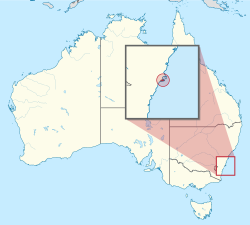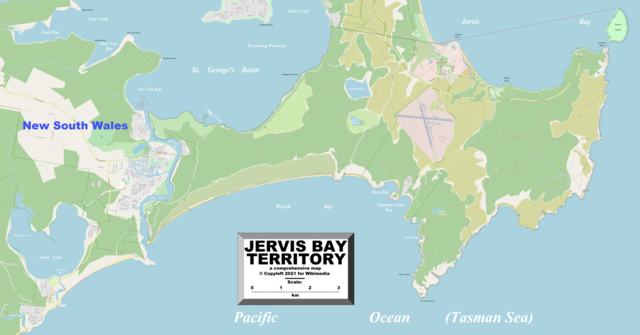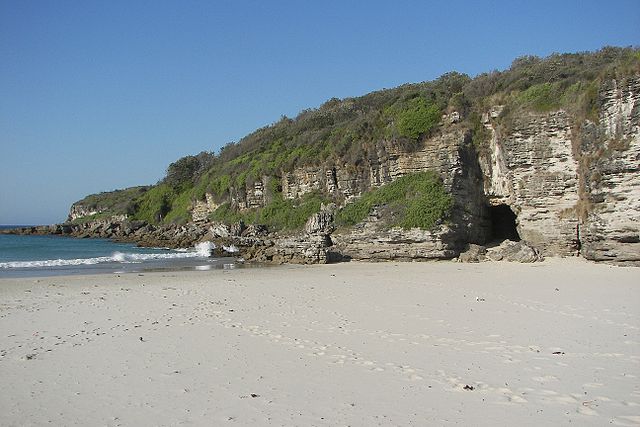Jervis Bay Territory
Territory in Australia From Wikipedia, the free encyclopedia
The Jervis Bay Territory (/ˈdʒɜːrvɪs, ˈdʒɑːr-/; JBT)[2][3][4] is an internal territory[5] of Australia. It was established in 1915, from a part of New South Wales (NSW),[6][7] in order to give the landlocked Australian Capital Territory (ACT) access to the sea.[8]
Jervis Bay Territory | |
|---|---|
 Location of the Jervis Bay Territory in Australia Coordinates: 35°8′55″S 150°42′49″E | |
| Country | Australia |
| Separation from New South Wales | 1915 |
| Named for | John Jervis, 1st Earl of St Vincent |
| Largest city | Jervis Bay Village |
| Government | |
• Administered by | Department of Infrastructure, Transport, Regional Development, Communications and the Arts |
| Parliament of Australia | |
• Senate | represented by Australian Capital Territory senators |
| included in the Division of Fenner | |
| Area | |
• Total | 67.8 km2 (26.2 sq mi) |
| Population | |
• 2023 estimate | 307[1] |
• Density | 5.8/km2 (15.0/sq mi) |
| Time zone | UTC+10:00 (AEST) |
| UTC+11:00 (AEDT) | |
| Postcode | NSW 2540 |
The territory was administered by the Department of the Interior (and later by the Department of the Capital Territory) as if it were part of the ACT, although it has always been a separate Commonwealth territory. The perception that it is part of the ACT stems from the fact that under the terms of the Jervis Bay Territory Acceptance Act 1915, the laws of the ACT apply to the Jervis Bay Territory.[9] In 1989, when the ACT achieved self-government, the Department of the Arts, Sport, the Environment, Tourism and Territories took over responsibility for the JBT's administration.
History
Jervis Bay has a long history of Aboriginal Australian settlement.[10]
Booderee, the name of the national park that covers the majority of the Jervis Bay Territory, means 'bay of plenty' or 'plenty of fish' in the local Aboriginal language.[10] The Yuin people have a strong and continuing connection to the Jervis Bay area and in December 2016, applied for recognition of their native title, in part to recognise this.[11]
Jervis Bay was sighted by Lieutenant James Cook aboard HMS Endeavour on 25 April, 1770 (two days after Saint George's Day), and he named the southern headland Cape St George.[12][13]
In August 1791, the bay was entered and named by Lieutenant Richard Bowen aboard the convict transport ship Atlantic of the Third Fleet in honour of Admiral John Jervis, under whom he had served.[12][13] In November 1791, Master Matthew Weatherhead aboard the Matilda entered the bay to undertake repairs.[13] Survivors of the Sydney Cove shipwreck in 1797, reached the area by foot, heading to Port Jackson.[13][14]
Explorer George Bass entered the bay on 10 December, 1797. He named Bowen Island. John Oxley, an English explorer and surveyor, travelled from Sydney by sea to explore the bay in 1819.[13]

During the negotiations that led to Federation, three major agreements were reached regarding proposed federal territories, including (in particular) the capital city of the proposed federation. First, it was decided that a new, purpose-built city, located within the borders of New South Wales (NSW), should become the federal capital.
Second, to allay fears that such a location would give NSW too much influence on federal politics, it was also agreed that an area including the new city would be exclaved from NSW – to become a small, separate federal territory. Third, it was also considered desirable, at the time, that the responsibilities and powers of the federal government should include direct control of, and jurisdiction over, at least one port and, therefore, an area of coastline.
Although the site of the capital city was not decided until 1908, most of the proposed sites were relatively long distances from the sea; hence it was also acknowledged (if only implicitly) that the capital and the port would be in separate, non-contiguous areas. In other words, it would have been onerous and unreasonable for NSW to have surrendered a single, contiguous area large enough to accommodate both port and capital. It was decided subsequently that Jervis Bay was the most practical location for a federally-controlled port. Ownership of Crown land in the area was transferred from the NSW government to the federal government in 1909 (at the same time that ownership of the site of Canberra and the surrounding area was also relinquished by NSW).[15]
In 1915, jurisdiction over the Jervis Bay Territory was also transferred from NSW to the Commonwealth.[16] To reduce the practical difficulties presented by the physical separation of the two territories, the government of NSW also agreed, in principle, that the federal government could build and take full control of a proposed rail corridor between Canberra and Jervis Bay,[citation needed] although this was never implemented.
Current constitutional status
The area of land and water owned by the Wreck Bay Aboriginal Community Council in the JBT is approximately 68 km2 (26 sq mi), which is about 90% of the land. The remaining land in the JBT is managed by the Department of Infrastructure, Regional Development and Cities. There is an Aboriginal community at Wreck Bay Village in Booderee National Park.
The Wreck Bay Aboriginal Community Council not only holds the majority of land in the Territory it exercises certain governance and representation functions for its community under the Aboriginal Land Grant (Jervis Bay Territory) Act 1986[17]
Administration
This section needs additional citations for verification. (September 2022) |

The Jervis Bay Territory is administered by the federal Department of Infrastructure, Transport, Regional Development, Communications and the Arts. However, it is counted as part of the ACT for the purpose of the ACT's representation in the Senate; it forms part of the Division of Fenner for House of Representatives purposes.[18]
For most purposes, the territory is governed under the laws of the Australian Capital Territory, by the Jervis Bay Administration, which handles matters normally concerned with local or state government. The ACT also provides primary school teachers and Australian Federal Police staffing. Residents have access to the courts of the ACT, but are not separately represented in the ACT Legislative Assembly. Although they are subject to ACT law and some services are contracted by the Australian Government to nearby councils in New South Wales, Jervis Bay Territory residents have no voting rights at ACT Legislative Assembly or NSW local elections. They do however have access to the decision-making process through community organisations. Further, Aboriginal persons who are registered members of the Wreck Bay Aboriginal Community Council have voting rights both at meetings of the Wreck Bay Aboriginal Community Council, and to elect the executive of that Council.
Section 61 of the Defence Force Discipline Act (DFDA) makes all Australian Defence Force members and "Defence Civilians" subject to the criminal laws of the Jervis Bay Territory regardless of where the offence occurred. This is a legal mechanism that makes Defence personnel subject to the Crimes Act 1914 (Cth), the Criminal Code Act 1995 (Cth) and offences against the criminal law of the ACT, as military law, even if the offence is committed elsewhere outside Australia.
The Commonwealth contracts the ACT government to provide various services like courts, education and welfare, the Government of New South Wales for rural fire services and community health, Shoalhaven City Council for waste collection and library services, and commercial providers for electricity and water supplies.
Geography
This section needs additional citations for verification. (February 2018) |


At the 2021 census, 310 people lived in the territory, the majority working and living at the Royal Australian Navy (RAN) base HMAS Creswell.[19] Vincentia is the nearest town, roughly 3 km (2 mi) north of the border.
Having 65.7 km2 (25 sq mi) of land and 8.9 km2 (3 sq mi) marine reserve,[20] Jervis Bay Territory is the smallest of all the mainland states and territories of Australia. Jervis Bay is a natural harbour 16 km (10 mi) north to south and 10 km (6 mi) east to west, opening to the east onto the Pacific Ocean. The bay is situated about 198 km (123 mi) south of the city of Sydney, on the southern coast of New South Wales. The nearest city is Nowra, about 40 km (25 mi) on the Shoalhaven River to the north. The majority of Jervis Bay embayment is part of Jervis Bay Marine Park (NSW State) but the waters within Jervis Bay Territory are part of Booderee National Park (Commonwealth). Booderee National Park was formerly known as Jervis Bay National Park (Commonwealth).
A wide variety of flora and fauna are native to the Booderee (Aboriginal: bay of plenty) National Park with approximately 206 species of birds, 27 species of mammals, 15 species of amphibians, 23 species of reptiles and 180 species of fish native to the area.[21] The park itself encompasses approximately 90% of the territory of Jervis Bay and covers the overlap between Australia's northern and southern climatic zones. Ancient sand dunes overlay the sedimentary bedrock formations formed from upheaval of the surrounding marine environment 280–225 million years ago.
There are three small lakes within the territory: Lake Windermere, the largest, with an area of 31 ha (77 acres); Lake Mckenzie, 7 ha (17 acres); as well as Blacks Waterhole measuring 1.4 ha (3.5 acres).
Bowen Island, at the entrance to the bay 230 m (750 ft) north of Governors Head, is 51 ha (130 acres) in area. It has rookeries for the little penguin Eudyptula minor.
Villages and leaseholds

There are two villages in the Jervis Bay Territory. They are both covered by postcode 2540. Listed from north to south, they are:
- Jervis Bay Village (population 128)[22]
- Wreck Bay Village (population 152)[23]
There are several private leasehold properties in the Jervis Bay Territory, within but not part of Booderee National Park.
Among these leasehold properties is a grouping of buildings known on the eastern foreshore of Sussex Inlet known as the Christian's Minde Settlement, which contain 6 separate parcels of land, four of which are leaseholds. The historical, heritage-listed Christian's Minde (Block 14) was founded in the mid-1880s by the Ellmoos family from Denmark.[24][25] Christian's Minde was promoted as the first guesthouse on the NSW south coast between Port Hacking and Twofold Bay when it was established in the 1890s. Descendants of the Ellmoos family lived at Christian's Minde (Block 14), Ellmoos (Block 9) and Ardath (Block 11) for over 130 years, and continue to live at Kullindi (Block 10) today. Members of the extended family are buried in a cemetery, which is surrounded by dense bush and is managed by the local Wreck Bay Aboriginal Community. Other leaseholds in Jervis Bay Territory are Pamir (Block 12) which is part of Christian's Minde Settlement, the Railway, Tram and Bus Union (RTBU) Holiday Park (Block 37) and The Cove (former Bay of Plenty Lodges) (Block 28).[26][27][28][29][30][31][32]
HMAS Creswell
Within the Booderee National Park is HMAS Creswell, the Royal Australian Navy College named after Sir William Rooke Creswell, the Director of the Commonwealth Naval Forces which later became the Royal Australian Navy (RAN).
The Jervis Bay Airfield is adjacent, operated by the RAN to support its BAE Systems Kalkara (Storm Petrel) pilotless target aircraft. Kalkaras are launched from the airfield and later recovered by parachute into the water and thence by boats maintained at HMAS Creswell, after target-towing exercises off the coast with ships or aircraft. Control equipment is sited at Bherwerre Ridge overlooking the sea to the east.[citation needed]
Proposed reactor site

Jervis Bay Territory was the proposed location for a nuclear power plant. The project, which was to be on the south east corner of the bay near Murray's Beach, was cancelled in 1971. This was after preparatory excavation and levelling had been done and an access road constructed between the site and the territory border. The levelled area is now the car park for Murray's Beach and its adjacent boat ramp.[33][34]
See also
References
External links
Wikiwand in your browser!
Seamless Wikipedia browsing. On steroids.
Every time you click a link to Wikipedia, Wiktionary or Wikiquote in your browser's search results, it will show the modern Wikiwand interface.
Wikiwand extension is a five stars, simple, with minimum permission required to keep your browsing private, safe and transparent.
